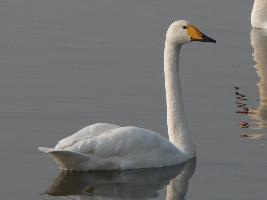
Weights and measures
| Length | 150 cm |
|---|---|
| Weight | from 4,5 to 8,2 kg |
| Wingspan | 200 cm |
Animal description
The Whooper Swan (Cygnus cygnus) is a large and magnificent bird that belongs to the waterfowl family Anatidae. It is closely related to the North American Trumpeter Swan (Cygnus buccinator) and shares many characteristics with its cousin, but it can be distinguished by its vocalizations and some physical features. This bird species is named for its distinctive whooping calls, which resonate across its habitats, adding a layer of acoustic beauty to its visually striking presence.Adult Whooper Swans are impressive in size, with a length ranging from 140 to 165 centimeters (55 to 65 inches) and a wingspan that can reach up to 275 centimeters (108 inches), making them one of the largest flying birds. They possess a body mass that varies between 8 and 12 kilograms (18 to 26 pounds), with males generally being larger and heavier than females. Their plumage is predominantly white, which splendidly contrasts with their long, elegant necks and the surrounding natural environments they inhabit. A key feature distinguishing them from other swan species is their black and yellow beak; the yellow extending towards the base of the beak in a variable pattern that is unique to each individual, much like a human fingerprint.
Whooper Swans breed in the subarctic and temperate regions of Eurasia, with their breeding range extending from Iceland, through Scandinavia, and across Siberia. They prefer freshwater environments such as lakes, slow-flowing rivers, and marshes with ample vegetation for nesting and feeding. During the breeding season, these swans are highly territorial and construct large nests out of vegetation, where they lay an average of 4 to 7 eggs. The cygnets are precocial and are tended to by both parents, learning to swim and feed within a few days of hatching.
In the winter months, Whooper Swans migrate to more temperate regions, traveling to the British Isles, Central Europe, and East Asia, including Japan. During this time, they can often be found in coastal lagoons, estuaries, and agricultural fields, where they feed on aquatic vegetation, roots, tubers, and occasionally small aquatic animals.
Whooper Swans are highly social outside of the breeding season, forming large flocks that can number in the hundreds. Their migratory journeys are impressive, covering thousands of kilometers and often involving high-altitude flights. These swans utilize a variety of vocalizations, including the characteristic "whooping" sound, to communicate with each other, especially during migration and in their wintering grounds.
Conservation efforts have been successful in some regions, leading to stable or increasing populations of Whooper Swans. However, they still face threats from habitat loss, pollution, and human disturbance, particularly in their breeding areas. International cooperation and conservation measures, including the protection of wetlands and the establishment of nature reserves, are crucial for ensuring the continued survival of this majestic bird species.
In summary, the Whooper Swan is a bird of extraordinary beauty and impressive capabilities, from its powerful flight to its distinctive vocalizations. Its presence enriches the biodiversity of the wetlands and serves as an indicator of the health of its habitats. As such, the Whooper Swan holds a cherished place in the natural heritage of the regions it inhabits and migrates through, symbolizing the importance of conservation and the interconnectedness of ecosystems across continents.
Similar Animals
New photos of animals
Top 10 animals
- Dolphin gull (Leucophaeus scoresbii)
- Diana monkey (Cercopithecus diana)
- Moustached guenon (Cercopithecus cephus)
- Galápagos tortoise (Geochelone nigra complex)
- Stone loach (Barbatula barbatula)
- Japanese macaque (Macaca fuscata)
- Greek tortoise (Testudo graeca)
- Russian tortoise (Testudo horsfieldii)
- Common flying dragon (Draco volans)
- Galápagos penguin (Spheniscus mendiculus)


